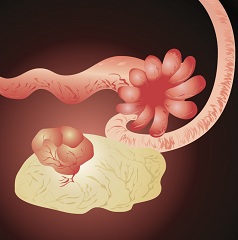Products
Contact Us
CanAg Diagnostics (Beijing) Co., Ltd.
Room 222, 2nd Floor, Building A1, Area A, No.80 Xingshikou Road, Haidian District, Beijing, China
Post code: 100195
Tel: +86 10 8528 8156
Fax: +86 10 8528 8382
E-mail :canag@canag.com.cn
Mobile Phone:17896035653
logistics Department
Tel:010-62883285
E-mail:order@canag.com.cn
The HE4 gene, also known as WFDC2, encodes a protein with a WAP-type four disulphide core (WFDC) domain. HE4 is one of 14 homologous genes on chromosome 20q12-13.1 which encode proteins with WAP-type four disulphide core (WFDC) domains . HE4 belongs to the family of whey acidic four-disulfide core (WFDC) proteins with suspected trypsin inhibitor properties but no biological function has so far been identified . Other proteins in this family include SLPI, Elafin, and PS20 (WFDC1) . Members of the WFDC family are characterized by an approximately 50 amino acid sequence with eight highly conserved cysteine residues that form four disulphide bridges . The HE4 gene codes for a 13kD protein, although in its mature glycosylated form the protein is approximately 20-25 kD, and consists of a single peptide and two WFDC domains .
Human epididymis protein 4 (HE4) was first identified in the epithelium of the distal epididymis and originally predicted to be a protease inhibitor involved in sperm maturation . HE4 was reported to be expressed in a number of normal tissues including epithelia of respiratory and reproductive tissues . Elevated levels were found in several tumor cell lines including ovarian, lung, colon and breast cancer. Most interestingly, HE4 is overexpressed 93% of serous, 100% of endometrioid epithelial ovarian cancers and 50% of clear cell but not in mucinous ovarian carcinomas . Although it is not tissue-specific, a number of independent microarray studies identified HE4 as one of the most useful biomarkers for ovarian cancer .
In addition to expression on a cellular level, secreted HE4 was detected in high levels in the serum of ovarian cancer patients (2) . Hellström et al. found elevated HE4 levels in cancer patients compared to healthy and to benign conditions in a case/control study. Furthermore, the area under the ROC curve was comparable to that of established biomarker CA125. At the chosen cut-off, HE4 achieved 96% specificity and 80% sensitivity comparing healthy subjects and cancer patients. Similar results were obtained in other studies using either the research ELISA system or a bead-based array system .
 HE4 EIA Prod.No.404-10K
HE4 EIA Prod.No.404-10K